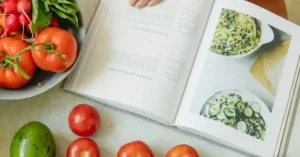The query today is: Will dinner tonight feature German cuisine? What do we actually imply when referring to German cuisine? In this article, our aim is to explore the benefits and standout aspects of German culinary traditions. Ready, set, let’s dive into the plates!
Introduction to German Cuisine
When you think of German cuisine, images of hearty, wholesome meals might come to mind. Steeped in a rich culinary heritage, German food offers a robust array of flavors integral to the country’s culture. From the bustling streets of Berlin to the quaint villages in Bavaria, traditional German dishes are designed to satisfy and comfort.
Germany’s gastronomic landscape is as diverse as its regions, each boasting its own signature dishes. In the north, seafood plays a significant role due to the proximity to the North and Baltic Seas, while in the south, you might indulge in dishes featuring rich cheeses and cured meats.
One common thread is the love for authentic meals that warm the heart. Sit down at a German table and you’re likely to find a spread that celebrates simple yet delicious ingredients, transformed into something truly special. Let’s take a peek at what you might find on a typical German menu:
| German Dish | Description |
|---|---|
| Schnitzel | Breaded and fried cutlet, often served with lemon wedges |
| Bratwurst | Iconic German sausage, typically accompanied by sauerkraut |
| Spaetzle | Soft egg noodle or dumpling, a versatile side dish |
| Sauerbraten | Slow-cooked and marinated roast, a Sunday dinner favorite |
| Pretzel | Twisted knot bread, often enjoyed with mustard |
| Black Forest Cake | Layered chocolate cake with cherries and whipped cream |
As you explore German cuisine, you’ll be greeted by a world of savory roasts, crisp schnitzels, and perhaps even an Oktoberfest favorite—pretzels as big as your face. Whether you’re a fan of bold flavors or simply looking for a taste of authenticity, your culinary journey through Germany promises to be a delightful experience.
Essential Ingredients
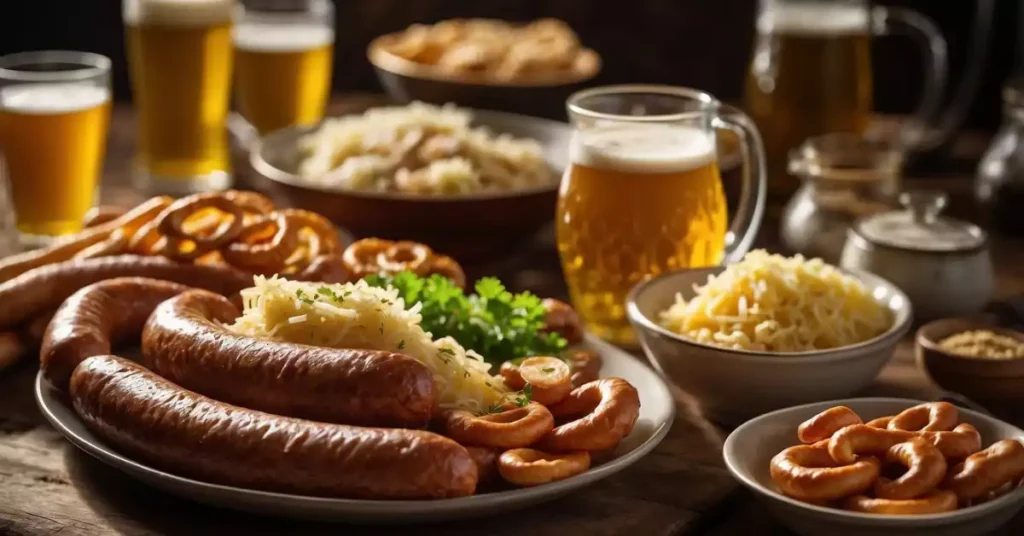
When planning your German dinner, some ingredients are the heart of the meal, and knowing them will help you create truly authentic dishes.
Meats and Proteins
German cuisine is well-known for its abundance of meat-based dishes. Here’s what you should consider adding to your shopping list:
- Sausages: There are over 1,500 types of wurst, with bratwurst and knackwurst being among the popular choices.
- Beef and Pork: Essential for making dishes like sauerbraten and schnitzel. You can’t go wrong with high-quality, lean cuts.
| Type | Detail |
|---|---|
| Beef | Use for: Sauerbraten |
| Pork | Use for: Schnitzel, Hocks |
| Bacon | For added flavor |
Vegetables and Sides

No German meal is complete without hearty sides. Here are the staples for a true German experience:
- Potatoes: Serve them boiled, mashed, or make German potato noodles, known as Schupfnudeln.
- Cabbage: From sauerkraut to braised red cabbage, this vegetable is versatile and pairs well with meats.
- Bread: Dark, whole-grain varieties are a must for mopping up sauces and gravies.
- Onions: Often caramelized or used raw to add a sharp kick to dishes.
Remember, whether you’re rendering down bacon for its rich fat or sautéing onions for that foundational flavor, each of these essentials will bring your German dinner closer to the authentic flavors you’re aiming for.
Popular Traditional Dishes
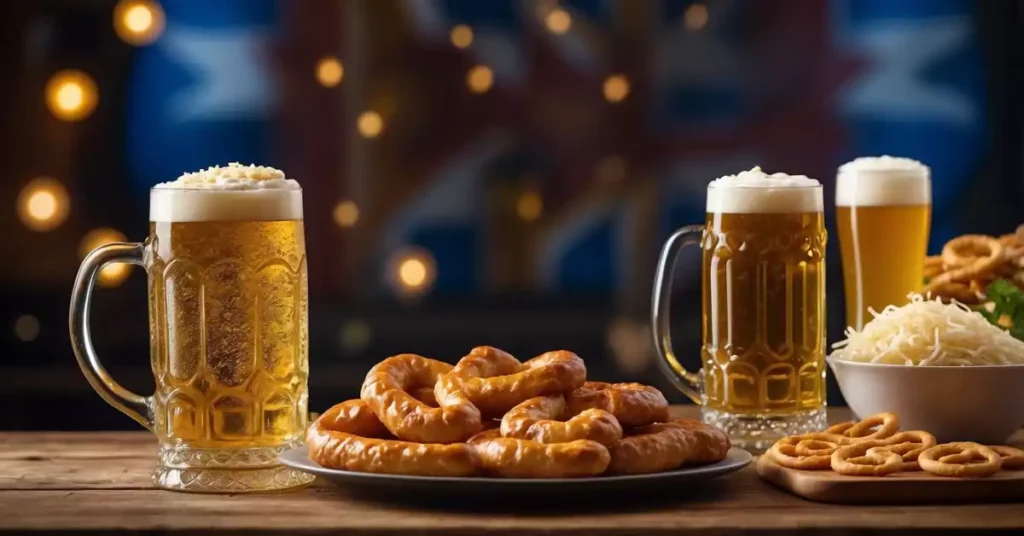
When you explore German cuisine, you’ll find an array of hearty main courses and flavorful sides that are ideal for dinner. These cherished dishes, from savory meats to tangy salads, create a satisfying meal that reflects Germany’s rich culinary traditions.
Main Courses
German dinners are often centered around robust and savory meat dishes. Here’s a snapshot of some classics:
- Sauerbraten: This is a marinated roast beef that’s slow-cooked until tender, making it a staple for a traditional German meal. Often served with a rich gravy, its flavors are deep and developed.
- Rouladen: Tender slices of beef rolled around a filling of bacon, onions, mustard, and pickles create this beloved dish. Typically enjoyed with a side of potato dumplings or red cabbage, this dish is a perfect example of German comfort food.
- Schnitzel: Arguably one of the most popular dishes, schnitzel consists of thin, breaded, and fried meat cutlets, usually pork or veal, that offer a crispy, golden coating with each bite.
- Bratwurst: No German menu is complete without this flavorful sausage, made of pork, veal, or beef. Whether pan-fried or grilled, enjoy your bratwurst with a dollop of mustard on top.
Sides and Salads

Table 1: Must-Try German Sides
| German Side Dishes | Description |
|---|---|
| Spaetzle | Egg noodles that pair perfectly with meats and gravies. |
| German Potato Salad | A tangy and warm salad, often dressed with vinegar and bacon. |
Pair your main dish with delightful sides like spaetzle, which are soft egg noodles that soak up the flavors of your meat’s sauce. Or, for something with a bit more tang, the German potato salad is a great choice, featuring a warm, vinegar-based dressing rather than the creamy mayonnaise of American versions. Its slight acidity complements the richness of German entrees beautifully.
Festive German Foods
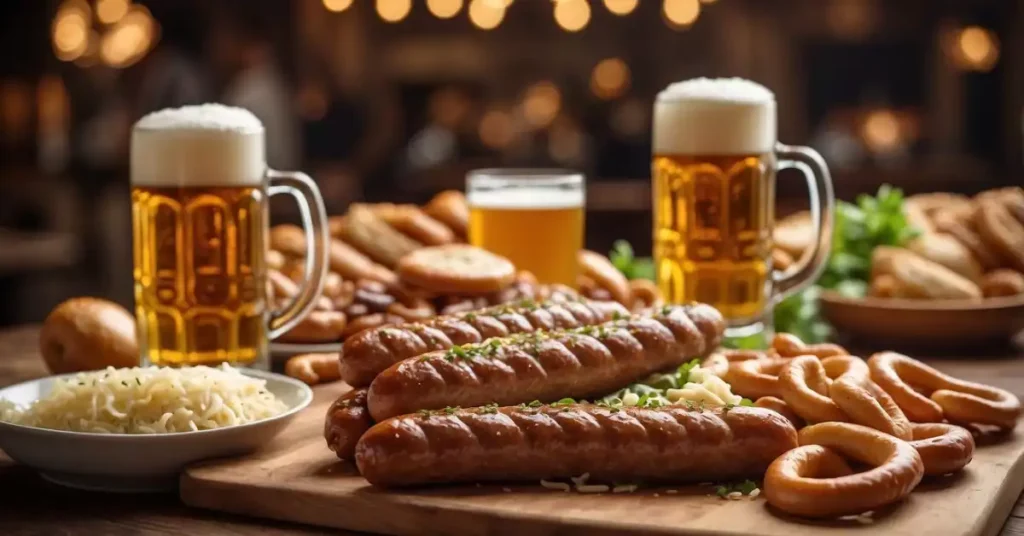
When you think of festive German foods, you’re in for a treat filled with rich traditions and delicious flavors that make any celebration memorable.
Oktoberfest Specials

Oktoberfest brings about a merry time of beer and bratwurst, but there’s a smorgasbord to explore beyond the iconic duo. Pretzels, or ‘Brezn’, are wonderfully salty and twisted delights that you’ll often find hanging in Bavarian beer tents. Served often with sweet mustard, they’re the perfect accompaniment to the bountiful mugs of beer. Speaking of beer, don’t forget to indulge in German mulled wine or Glühwein—a warm, spiced beverage that is a staple at Germany’s many festive gatherings, especially as the season cools.
Menu for Oktoberfest Delights
| Dish | Description |
|---|---|
| Pretzels | Freshly baked and salted with a chewy, golden crust. |
| Bratwurst | Hearty German sausages often served with sauerkraut. |
| German Mulled Wine | A warm, spiced wine, sweetened to taste and served hot. |
| Potato Dumplings | Fluffy, boiled dumplings, a comforting side to meats. |
Christmas Delicacies
Come Christmastime, German cuisine takes a festive turn with a spread that’s sure to warm your heart on those chilly winter days. Their Christmas Delicacies feature hearty meats and sweet treats that are a point of pride at holiday gatherings. A perennial favorite is the Christstollen, which is a fruitcake rich with dried fruits, nuts, and often filled with marzipan, symbolizing the swaddled baby Jesus. Lovers of savory foods will rejoice at the traditional Rouladen—thinly sliced beef rolled with pickles, bacon, onions, and mustard—often accompanied by potato dumplings (Kartoffelknödel) for a complete, satisfying holiday meal.
Christmas Indulgence
- Christstollen: A fruity, nutty bread with a hint of sweetness from the marzipan within.
- Rouladen: Tender beef rolls with a tart and savory filling, demanding a place at the holiday table.
- Lebkuchen: Soft, spiced gingerbread cookies, dressed with almonds and glazed to perfection.
- Potato Dumplings: A traditional side, perfect for soaking up those rich, holiday gravies and sauces.
German Baking and Desserts

When you think of German cuisine, hearty meals might spring to mind, but Germany’s baking traditions offer a delightful array of breads and desserts. From the iconic German breads to the country’s rich, fruit-filled sweets, there’s much to savor.
Breads

German bread, known for its variety and heartiness, is an integral part of the country’s culinary identity. Each region boasts its own specialties, but many of the breads share a common characteristic: a dense, flavorful crumb often enhanced by whole grains and seeds. For instance:
- Vollkornbrot – A whole grain bread that’s both robust and nutritious.
- Pumpernickel – A dark rye bread with a distinctive sweet, sour flavor profile.
Here’s a quick guide to some German bread favorites:
| Bread Type | Main Ingredients | Characteristics |
|---|---|---|
| Vollkornbrot | Whole grain flour, seeds, nuts | Dense, chewy texture, highly nutritious |
| Pumpernickel | Rye flour, sourdough | Dark color, sweet taste, long baking time |
| Brötchen | Wheat flour, yeast | Crisp outside, fluffy inside, the classic breakfast roll |
| Pretzel (Brezel) | Wheat flour, malt, yeast, salt | Distinctive knot shape, shiny crust, salty finish |
Desserts and Sweets

Now, let’s dive into the sweet side of German baking. German desserts offer a rich variety, often featuring fruits and custards. Apple strudel is one well-known dessert, embodying the perfect balance of tender pastry and spiced apple filling. Another favorite is the German pancake, also known as Pfannkuchen, which is similar to the French crêpe and can be enjoyed with sweet or savory toppings.
Infused with tradition and flavor, here are a few German sweets to tempt your tastebuds:
- Apple Strudel (Apfelstrudel) – Thin sheets of dough wrapped around a sweet apple filling.
- Black Forest Cake (Schwarzwälder Kirschtorte) – Chocolate layers with cherries and whipped cream.
Embrace your sweet tooth with these treats:
| Dessert | Description |
|---|---|
| Apple Strudel | Flaky pastry, spiced apples, often served with ice cream |
| Black Forest Cake | Layers of chocolate cake, cherries, and whipped cream |
| German Chocolate Cake | Rich chocolate cake with coconut-pecan frosting |
| German Pancake (Pfannkuchen) | Thin, versatile pancake, often dusted with powdered sugar |
Whether you’re a fan of savory or sweet, German baking and dessert traditions are sure to provide something delightful for your table. Enjoy exploring these tasty breads and tempting treats next time you crave a touch of German culinary culture.
Typical German Flavors and Spices
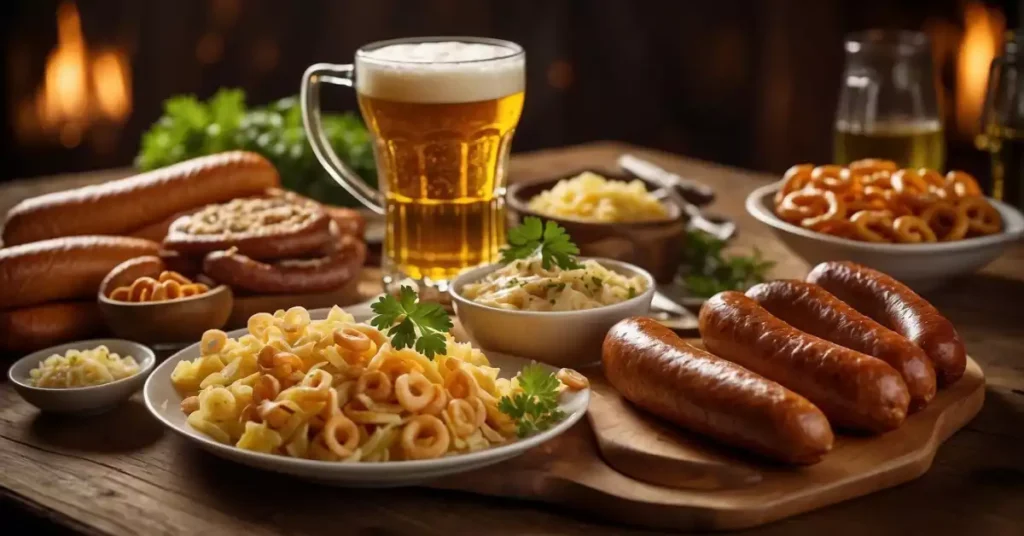
When you think about German cuisine, you’re immediately taken to a world of hearty meals enriched with distinctive flavors and spices that are central to their cooking traditions. Many of these seasonings go back centuries, playing a vital role in defining the character of German dishes—whether it’s a comforting bowl of sauerkraut or a succulent roast. Here’s a peek at the spices and flavors you’re likely to encounter in a traditional German kitchen.
| Spice | Used in | Flavor Profile |
|---|---|---|
| Paprika | Paprikaschnitzel | Mild to sweet |
| Mustard | Rouladen | Tangy and sharp |
| Caraway | Breads and Cabbage dishes | Earthy and peppery |
| Cinnamon | Sweet dishes and broths | Warm and sweet |
| Nutmeg | Cream sauces and soups | Warm and slightly nutty |
Revered for its savory goodness, German cuisine often includes mustard and sage, delivering a pungent kick and a pine-like aroma, respectively.
Their sweet side isn’t overlooked either. Cinnamon and nutmeg frequently find their way into both dessert and savory creations, offering that perfect balance of sweetness with depth.
Not to forget, a helping of sauerkraut, fermented with care, adds a delightful tanginess to your plate while punching up the probiotic quotient.
To cook with these spices, it’s best to incorporate them thoughtfully to respect their potent flavors. German cooking is an exciting culinary adventure; it’s about the simple delight in the richness of flavors. Whether you’re rolling up a rouladen or seasoning a potato salad, these spices and herbs will definitely take your dishes to new delicious heights.
Easy German Recipes for Beginners
Starting your journey into German cooking can be both exciting and straightforward. There’s a world of flavors waiting for you, from savory sausages to crispy potato pancakes. Let’s dive into some uncomplicated dishes that will bring a taste of Germany to your table without any hassle.
Quick Meals
Currywurst

Currywurst is a beloved street food in Germany that’s incredibly easy to prepare at home. All you need is some quality bratwurst sausages, which are then sliced and drizzled with a curry-ketchup sauce. The sauce is simply a blend of ketchup and curry powder, heated and poured over the cooked sausage.
| Ingredients | Quantity |
|---|---|
| Bratwurst | 4 sausages |
| Ketchup | 1 cup |
| Curry Powder | 2 tablespoons |
| Paprika | 1 teaspoon |
Pair your currywurst with a crusty roll or a light salad for an uncomplicated yet satisfying meal.
Simple Sides
Potato Pancakes

Classic German potato pancakes, known as “Reibekuchen,” are an absolute must-try. They are crispy, delicious, and easy to whip up with just a few ingredients:
- Potatoes: grated and squeezed to remove excess moisture.
- Onions: finely chopped for flavor.
- Eggs: to bind the pancakes together.
- Flour: a small amount for structure.
- Salt and pepper: for seasoning.
Combine the ingredients, form into patties, and then fry until golden brown on both sides. Serve hot with applesauce or sour cream for a truly authentic experience.
With these recipes in your repertoire, you’ll be able to enjoy German cuisine any night of the week. Whether you’re craving a hearty quick meal or need a simple side dish, these beginner-friendly recipes will transport your taste buds straight to Germany.
Advanced German Cooking
Diving into advanced German cooking, you’ll encounter complex dishes and authentic techniques that are rich in tradition and flavor. This journey will elevate your culinary skills and offer a deeper appreciation for Germany’s gastronomic culture.
Complex Dishes
Beef Rouladen
- Preparation: Thinly sliced beef rolled with bacon, onions, mustard, and pickles, cooked until tender.
- Cooking: Slow-braised in a rich gravy.
Bread Dumplings
- Ingredients: Stale bread, milk, eggs, flour, and parsley.
- Serving Suggestion: Typically served with roasts or thick sauces.
Table: Sample Menu for Advanced German Dinner
| Course | Dish | Description |
|---|---|---|
| Main Course | Beef Rouladen | A savory roll-up of beef, highlighting the precision in German cooking |
| Side | Bread Dumplings | A staple side, perfect for soaking up sauces and gravies |
| Special Mention | Zürich Ragout | A Swiss influence, this creamy veal dish is a testament to the finesse in regional cooking |
Authentic Techniques
Searing and Deglazing
- For dishes like Zürich Ragout, start by searing meat to develop depth of flavor, followed by deglazing the pan to create a rich, smooth sauce.
Dumpling Preparation
- To achieve the iconic texture of Bread Dumplings, combine your ingredients and allow them to rest so flavors can meld together, ensuring your dumplings are fluffy and full-bodied.
By mastering these dishes and techniques, you’ll be able to recreate the warmth and richness of authentic German recipes in your own kitchen.
Incorporating German Flavors into Daily Meals

Embarking on a culinary adventure with German cooking can bring hearty and robust flavors to your everyday meals. Embrace the comforting warmth of traditional recipes and let the rich tapestry of German food unfold in your kitchen.
- Start your day right: Begin by introducing German flavors into your breakfast. Add a slice of wholesome Bauernbrot, a dense rye bread, perfect for pairing with your morning coffee.
- Lunchtime delights: For a midday meal, consider a simple yet filling Leberkäsesemmel, a baked loaf that’s similar to meatloaf, served in a crusty roll with a dollop of mustard.
Here’s a sample menu to kickstart your week:
| Day | Meal | German Dish |
|---|---|---|
| Monday | Dinner | Sauerkraut Soup |
| Tuesday | Dinner | Bratwurst with Red Cabbage |
| Wednesday | Dinner | Pork Tenderloin with Apples |
| Thursday | Dinner | Schnitzel with Potato Salad |
| Friday | Dinner | Sauerbraten with Dumplings |
| Saturday | Dinner | Rouladen with Spaetzle |
| Sunday | Dinner | Kasespatzle with green salad |
- Snack time: Satisfy your cravings with a soft Pretzel or a slice of Obsttorte (fruit tart), which provides that sweet, yet not overly sugary, taste.
Incorporating German flavors into your meals doesn’t have to be a chore. With these tasty and traditional recipes, you can enjoy the rich and hearty essence of German cuisine any day of the week.
Cultural Significance of Food in Germany

When you think about German culture, hearty foods and time-honored traditions might spring to mind. German cuisine is an integral part of the nation’s heritage, with traditional German meals bringing family and friends together. Sharing a German recipe at the dinner table is more than just a way to satisfy hunger – it’s a ritual that strengthens bonds and celebrates German history and regional diversity.
| Meal Time | Typical Dishes |
|---|---|
| Breakfast | Brötchen, assortment of meats, cheeses |
| Lunch | Schnitzel, sausages, sauerkraut |
| Dinner | Hearty stews, potato dishes, breads |
In Germany, dinner isn’t just about the food; it’s a time to unwind from the day. You’ll find that tables are set with care, often featuring bread (an essential element) and a variety of meats and cheeses.
A German dinner might highlight local specialties. For example, in Bavaria, you could be enjoying a pretzel with your Weißwurst, while in Hamburg, a piquant Labskaus may be on the menu. The recipes passed down through generations are a testament to the country’s rich history, each telling a story of regional climates, economic conditions, and foreign influences.
Consider the famous Oktoberfest; it’s not just a beer festival but a celebration of Bavarian food culture. Here, traditional German meals like Hendl (roast chicken) and Knödel (dumplings) are enjoyed with merriment.
From the simple yet satisfying Abendbrot (evening bread) to the complex flavors of Maultaschen (stuffed pasta from the south), German recipes offer a taste of this collective experience. Enjoying a German dinner connects you to the spirit of Gemütlichkeit – a feeling of warmth, friendliness, and good cheer.
Our Opinion: German for Dinner?
Well, who isn’t hungry now? German for dinner is always a good idea. There is the possibility to choose between the many directions. Whether savory or sweet. With meat or vegetarian. The choice is always possible here. Go for it and try the unknown. Take courage, it will pay off.
FAQ: German for Dinner?
What are some traditional German dinner dishes?
Popular dishes include Schnitzel, Sauerbraten, and Bratwurst.
What are common side dishes in German cuisine?
Potato salad, sauerkraut, and red cabbage are popular choices.
Are there any vegetarian options in German cuisine?
Yes, dishes like Käsespätzle (cheese noodles) and Kartoffelsalat (potato salad) are vegetarian-friendly.
Did you ever thought, that today is the perfect day for some German for Dinner? Did you enjoy it? Let us know in the comments below.




